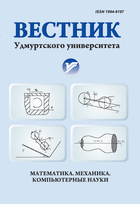Все выпуски
- 2025 Том 35
- 2024 Том 34
- 2023 Том 33
- 2022 Том 32
- 2021 Том 31
- 2020 Том 30
- 2019 Том 29
- 2018 Том 28
- 2017 Том 27
- 2016 Том 26
- 2015 Том 25
- 2014
- 2013
- 2012
- 2011
- 2010
- 2009
- 2008
-
Классическим свойством периодической функции на вещественной оси является возможность ее представления тригонометрическим рядом Фурье. Естественным аналогом условия периодичности в евклидовом пространстве $\mathbb{R}^m$ является постоянство интегралов от функции по всем шарам (или сферам) фиксированного радиуса. Функции с указанным свойством можно разложить в ряд Фурье по сферическим гармоникам, коэффициенты которого разлагаются в ряды по функциям Бесселя. Этот факт допускает обобщение на векторные поля в $\mathbb{R}^m$, имеющие нулевой поток через сферы фиксированного радиуса. В данной работе изучаются векторные поля с нулевым потоком через окружности фиксированного радиуса на плоскости Лобачевского $\mathbb{H}^2$. Получено описание таких полей в виде рядов по гипергеометрическим функциям. Результаты, полученные в работе, можно использовать при решении задач, связанных с гармоническим анализом векторных полей на областях в $\mathbb{H}^2$.
A classic property of a periodic function on the real axis is the possibility of its representation by a trigonometric Fourier series. The natural analogue of the periodicity condition in Euclidean space $\mathbb{R}^m$ is the constancy of integrals of a function over all balls (or spheres) of fixed radius. Functions with the indicated property can be expanded in a Fourier series in terms of spherical harmonics whose coefficients are expanded into series in Bessel functions. This fact can be generalized to vector fields in $\mathbb{R}^m$ with zero flux through spheres of fixed radius. In this paper we study vector fields which have zero flux through every circle of fixed radius on the Lobachevskii plane $\mathbb{H}^2$. A description of such fields in the form of series in terms of hypergeometric functions is obtained. These results can be used to solve problems concerning harmonic analysis of vector fields on domains in $\mathbb{H}^2$.
-
Рассмотрена задача оптимального управления движением космического аппарата при коррекции его положения в инерциальной системе координат за счет управляющих моментов, получаемых от ускорений инерционных маховиков бесплатформенной инерциальной навигационной системы. Полученное оптимальное управление обеспечивает плавное изменение ориентации космического аппарата, которое рассматривается как движение по кратчайшей траектории в конфигурационном пространстве специальной ортогональной группы $SO(3)$. Алгоритм управления реализуется с использованием оригинальной процедуры нелинейной сферической интерполяции кватернионов. Основными исполнительными органами ориентации динамического контура управления бесплатформенной инерциальной навигационной системой при решении задачи оптимального управления были выбраны четыре инерционных маховика (три - по осям космического аппарата, четвертый - по биссектрисе). Результаты моделирования верифицируются путем создания анимации корректирующего движения космического аппарата.
космические аппараты, бесплатформенные инерциальные навигационные системы, управляющие моменты, плавное движение
Optimal stabilization of spacecraft in an inertial coordinate system based on a strapdown inertial navigation system, pp. 252-259We consider the optimal control problem for spacecraft motion during correction of its position in an inertial coordinate system by means of control torques. Control torques arise from the acceleration of inertial flywheels of a strapdown inertial navigation system. We investigate optimal control, which ensures a smooth change in the spacecraft orientation. This smooth corrective motion is described as the motion along the shortest path in the configuration space of a special orthogonal group $SO(3)$. The shortest path coincides with the large circle arc of the unit hypersphere $S^3$. We also consider a control algorithm using the original procedure of nonlinear spherical interpolation of quaternions. Four inertial flywheels are used as the main executive bodies for orientation of the dynamic control loop of the strapdown inertial navigation system when solving the optimal control problem. Three flywheels are oriented along the axes of the spacecraft. The fourth flywheel is oriented along the bisector. The simulation results are presented. We consider examples for corrective motion in which the spacecraft has zero velocity and acceleration at the beginning and end of the maneuver. We give an animation of the corrective movement of the spacecraft. The proposed formalism can be extended to control the spacecraft motion at an initial angular velocity different from zero, as well as in the orbital coordinate system.
Журнал индексируется в Web of Science (Emerging Sources Citation Index)
Журнал входит в базы данных zbMATH, MathSciNet
Журнал включен в базу данных Russian Science Citation Index (RSCI) на платформе Web of Science
Журнал входит в систему Российского индекса научного цитирования.
Журнал включен в перечень ВАК.
Электронная версия журнала на Общероссийском математическом портале Math-Net.Ru.




